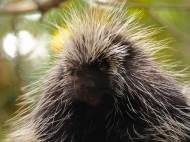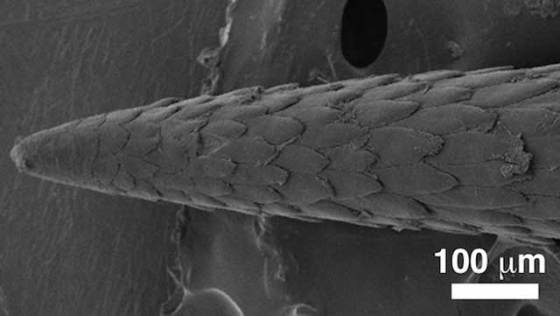Porcupine’s quill biomimicry could find medical applications
 North American porcupine upper parts are covered with thousands of sharp, barbed hollow spines (quills), which are used for defense. The ability of these quills to easily penetrate tissues are often hard to remove once lodged in flesh intrigued an international group of researchers, and their investigation might inspire development of medical needles that easily penetrate surfaces and resist buckling, as well as create next-generation medical adhesives.
North American porcupine upper parts are covered with thousands of sharp, barbed hollow spines (quills), which are used for defense. The ability of these quills to easily penetrate tissues are often hard to remove once lodged in flesh intrigued an international group of researchers, and their investigation might inspire development of medical needles that easily penetrate surfaces and resist buckling, as well as create next-generation medical adhesives.
The North American porcupine (Erethizon dorsatum) has approximately 30,000 defensive quills on its back. The porcupine releases its quills upon contact with predators. Each quill contains a conical black tip studded with a layer of microscopic, backward-facing barbs and a cylindrical base with smooth, scale-like structures.
Led by a researcher from Brigham and Women’s Hospital (BWH), the researchers used natural porcupine quills and replica-molded synthetic polyurethane (PU) quills to understand the physical forces at play when the quills penetrate and are removed from a variety of tissues, including muscle and skin. The results revealed that the quill’s geometry enables it to penetrate tissue with ease, and once in the tissue it maintains high adhesion.
After carefully removing the barbs from the quill, the researchers discovered that in addition to their physical features, the location of barbs on the quill played a major role in minimizing penetration forces and maximizing the work needed to remove them from the tissue.
North American porcupine quills have two distinct regions – the conical black tip which contains a layer of microscopic backward facing barbs on its surface, and the cylindrical white base which contains smooth scale-like structures. Barbs slightly overlap and have dimensions ranging from 100 to 120 μm in length, and they have up to 45 μm in width. The size of the barbs becomes larger farther from the apex of the tip.
“The philosopher Aristotle who was clearly misinformed warned that porcupines could shoot their quills over great distances, which is completely untrue”, said senior study author Jeffrey Karp, PhD, BWH Division of Biomedical Engineering, Department of Medicine. “In fact there are many misconceptions about porcupines and their quills. We were most surprised to find that the barbs on quills serve a dual function. Namely, the barbs reduce the penetration force for easy insertion into tissue and maximize the holding force to make the quills incredibly difficult to remove.”
Reproducing the strong tissue adhesion property of the porcupine quill would be useful for the development of mechanically interlocking tissue adhesives. As a proof of concept, the researchers fabricated am artificial PU quill in 8 different configurations of its 4 1-mm-long segments. The data suggests that barbs in different regions likely work cooperatively. The results also revealed that the quill-mimetic patch is unique in that it can both easily penetrate tissue and achieve high tissue adhesion.
While the quill is entering tissue, the barbs act to localize the penetration forces, allowing them to tear through tissue fibers much more easily. Compared to quills with no barbs, the barbed quills require about 50 percent less force to penetrate muscle tissue. When it comes to the force required for pullout, the barbs act like anchors that keep the quill from coming out. The force required to pull out barbed quills is four times that required to remove barbless quills.
BWH researchers plan to test the synthetic porcupine quill approach in a variety of medical applications, and new findings could lead to advances in local anesthesia, abscess drainage, vascular tunneling, and trocar placement, as well as new mechanically interlocking tissue adhesives.
For more information, you can read the article published in the Proceedings of the National Academy of Sciences: “Microstructured barbs on the North American porcupine quill enable easy tissue penetration and difficult removal” [994KB PDF].










Leave your response!